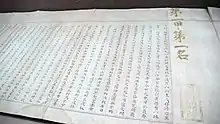Zhuangyuan
Zhuàngyuán, or trạng nguyên in Vietnamese, variously translated into English as principal graduate, primus, or optimus,[1] was the title given to the scholar who achieved the highest score on highest level of the Imperial examination,省試(in Tang) and 殿試(in Song)[2] in ancient China and Vietnam.
| Zhuangyuan | |||||||||
|---|---|---|---|---|---|---|---|---|---|
 Imperial exam paper of Ming dynasty Zhuangyuan Zhao Bing-zhong in 1598 AD | |||||||||
| Chinese name | |||||||||
| Traditional Chinese | 狀元 | ||||||||
| Simplified Chinese | 状元 | ||||||||
| Hanyu Pinyin | zhuàngyuán | ||||||||
| |||||||||
| Vietnamese name | |||||||||
| Vietnamese alphabet | trạng nguyên | ||||||||
| Chữ Hán | 狀元 | ||||||||
In China, Fu Shanxiang is known as the first (and last) female zhuangyuan (nü zhuangyuan) in Chinese history, but under the Taiping Tianguo, not the regular imperial exams. After the Taipings captured the city of Nanjing, they offered an exam for women in January 1853 in which Fu attained the highest score. [3]
In Vietnam, the first and only trạng nguyên in the history is Lê Văn Thịnh, who lived in the Lý Dynasty era and was the one who persuaded the Song to give back 6 distincts of Quảng Nguyên (today Hà Giang province) to Vietnam. The first female trạng nguyên (nữ trạng nguyên) is Nguyễn Thị Duệ who later become a consort of the Mạc Emperor Mạc Kính Cung and later become a consort of the Lê Emperor Lê Thần Tông and well as an official of a Trịnh lord after the fall of the Mạc Dynasty.
In China
In total, there were 596 zhuangyuan in ancient China.[4]
Noteworthy zhuangyuan
- Chen Wenlong
- Weng Tonghe
- Hong Jun
- Fu Shanxiang, Taiping Heavenly Kingdom, the first and only woman to become a zhuangyuan
- Mo Xuanqing, was the youngest Zhuangyuan in the imperial examinations during the Tang Dynasty
- Sun Fujia, (zh:孫伏伽 (?-658), Tang Dynasty dali qing (chamberlain of the Court of Judicial Review), highly regarded for his candid advice to Gaozu and Taizong, the first zhuangyuan in history.
- Tang Gao, became the Zhuangyuan in the ninth year (1514) of the Zhengde Emperor's reign during the Ming Dynasty
- Wen Tianxiang, was a scholar-general in the last years of the Southern Song Dynasty. For his resistance to Kublai Khan's invasion of the Song, and for his refusal to yield to the Yuan Dynasty despite being captured and tortured
- Yu Minzhong, who served as chief grand councilor for part of the reign of the Qianlong Emperor of Qing Dynasty.
- Liu Chunlin (zh:劉春霖 (1872-1942), Qing Dynasty), the last zhuangyuan in Chinese history.
In Vietnam
In total, there were 56 trạng nguyên in ancient Vietnam.
Noteworthy Trạng nguyên
- Lê Văn Thịnh, the first trạng nguyên in history.
- Huyền Quang, real name Lý Đạo Tái, a politician and later Buddhist monk who lived during the reign of Emperor Trần Nhân Tông during the Trần Dynasty. He was considered to be equal with the first six patriarchs of the Zen Buddhist tradition.
- Nguyễn Hiền, the youngest to become a trạng nguyên when he was 13 years old, later died at 21 years old. He also many times become a envoy to meet the Yuan Dynasty
- Mạc Đĩnh Chi (莫挺之,1272–1346) a scholar and envoy who served three emperors of the Trần Dynasty, as well as the ancestor of the first emperor of the Mạc Dynasty Mạc Thái Tổ
- Nguyễn Trực
- Phạm Đôn Lễ
- Lương Thế Vinh (梁世榮, 1441-1496) a mathematician, buddhist and poet live during Emperor Lê Thánh Tông's reign
- Nguyễn Bỉnh Khiêm
- Nguyễn Thị Duệ, the first and only female trạng nguyên
- Nguyễn Đăng Đạo
- Trịnh Tuệ
- Phan Đình Phùng
- Nguyễn Phong Di, the last trạng nguyên in history.
In modern culture
In modern Chinese, zhuangyuan is used to refer to anyone who achieves the highest mark on a test, or, more generally, to anyone who is at the forefront of his or her field.[5] In mainland China, the term is most often used to refer to the highest score at the provincial level for either the social sciences (文科) or physical sciences (理科) track of the annual gaokao college entrance exam.
See also
References
-
- Hucker, Charles O. (1985). Dictionary of Official Titles of Imperial China. Stanford: Stanford University Press. p. 187.
- 萧源锦,《狀元史話》,重庆出版社,1992,ISBN 7-5366-1648-1
- Mao (1998), p. 43.
- 萧源锦,《狀元史話》,重庆出版社,1992,ISBN 7-5366-1648-1
- 《现代汉语词典》,商务印书馆,第五版,ISBN 7-100-04385-9
Further reading
- Mao, Jiaqi (Grace Chor Yi Wong tr.) (1998), "Fu Shanxiang", in Ho, Clara Wing-chug (ed.), Biographical Dictionary of Chinese Women, Armonk, NY: Sharpe, pp. 43–45, ISBN 0765600439